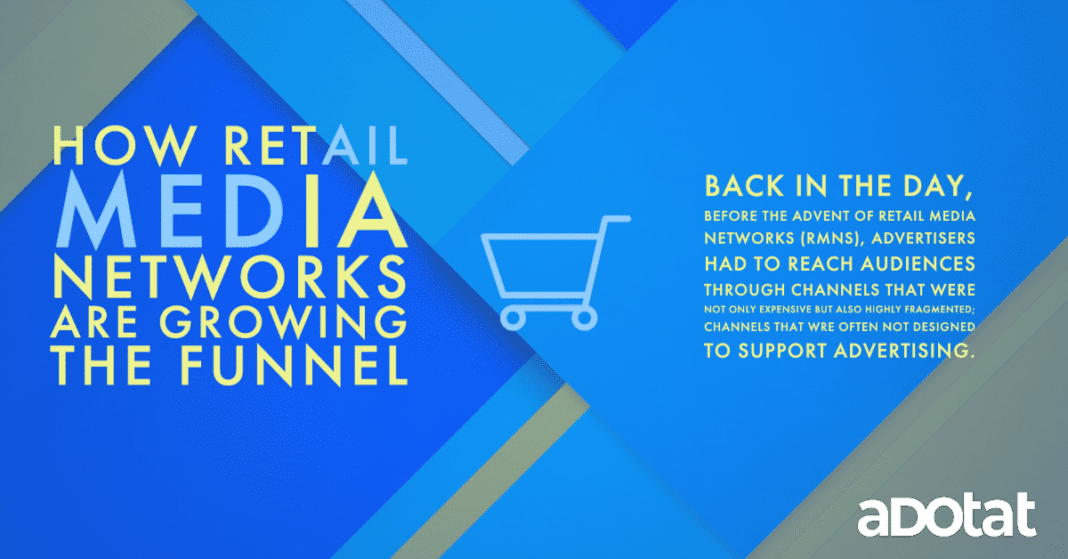Before the advent of retail media networks (RMNs), advertisers had to reach audiences through expensive and highly fragmented channels; channels that were not only expensive but also highly fragmented; channels that were often not designed to support advertising.
This is where RMNs stepped in—providing advertisers with a conduit to both audiences (1st party) and channels (retail sites, apps, etc.) they previously couldn’t access. It was a gold rush mentality that lured dollars toward RMNs. And it led to an expansion of their available tactics—both on the buy side and sell side.
This tactical growth path for RMNs is based on a simple premise: Create a full-funnel offering, unlocking even more advertising dollars in the process.
But as the retail media funnel becomes longer, advertisers are realizing that they can’t be siloed—that is, owned by separate non-communicating entities in corporate structures. Instead, their job is to coalesce with larger marketing funnels.
Retailers are being asked to do more than ever.
Not only are they expected to provide inventory and customer data to fuel targeting, they’re also expected to act as the media buying experts for their own inventory.
That’s a tall order, but it’s one that retailers need to embrace if they want to remain competitive.
Retail media networks use a customer’s transaction history to drive sponsored product ads onto the retailer’s own site for complementary products or for previously bought items. We’ve read about this a thousand time in industry media.
As retail media networks become more sophisticated and offer advertisers full-funnel, multi-property strategies for reaching consumers across channels there is more here:
“We define commerce media really a lot bigger than just those low-funnel tactics that we’ve all known and bought over the years across the Amazon and Walmart and those other retailers,” Jill Cruz, executive vice president, of commerce strategy, at Publicis Groupe, said in an interview on BeetTv.
“I defined commerce media more as a new form of advertising that takes a media impression all the way to a commerce transaction, It really could be upper funnel to lower funnel, if you think about it — as long as it has a certain commerce outcome.”
For instance, the advertiser can take out sponsored product ads on the retailer’s site as well as target CTV ads to shoppers via third-party platforms—acting like an agency of record along the way.
Cooperative social advertising can help drive shoppers who are already interested in a brand’s products to the retailer’s site, benefitting both parties.
No matter how you spin it, retailers are in a prime position to help advertisers plan their retail media spending. After all, they know what you want before you do—and that data is gold.
Retail partners should provide advertisers with unified dashboards to help them understand how their media investment is performing across channels so that they can continue optimizing their ad mix over time.
In this day and age, many marketers are looking for ways to get more granular insight into their campaigns—especially when it comes to first-party data. They want to know where their ads are showing up and what kind of impact they’re having on consumers.
Retailers have been stepping up their game in this area, offering their own media networks that allow brands to reach shoppers with targeted ads while also giving them access to campaign insights.
Albertsons’ audience and measurement solution with The Trade Desk and Walmart and Amazon’s API connections exemplify current features of retail media networks, allowing brands to dig deeper into marketing performance to iterate and optimize campaigns.
By relying on a retailer with the consensual first-party data of a shopper that it wants to reach, a brand can get the granular intelligence it needs without using third-party cookies—and all while keeping consumer privacy intact!
According to a new survey from McKinsey, advertisers are spending just as much money on brand-building campaigns in RMNs as they are on performance marketing—and that’s not all.
McKinsey surveyed almost 200 advertisers about their anticipated RMN spend allocations across objectives in the next 1-2 years. The results suggest an almost equal weighting between performance marketing (35% share), brand building/campaigns (34%), and shopper/co-op marketing (31%). This distribution was relatively consistent across advertiser types, whether CPG, Apparel/Footwear, Beauty, or Consumer Electronics.
The study also debunks other commonly held beliefs about retail media. For example, while advertising on Amazon is becoming big business—the company now sells over $10 billion in products annually and has 80 million users worldwide—it’s not the only game in town: 80% of advertisers are currently using at least one network other than Amazon.
Privacy concerns have made it difficult for marketers to assess the effectiveness of their campaigns. By relying on the organization that has consensual first-party data from the shoppers an advertiser wants to reach for marketing insights, advertisers can skip measurement hoops and get granular intelligence straight from the source. This approach will give you accurate and reliable data.
The rise of retail media networks is among the hottest digital advertising trends in years — the sector is expected to account for nearly 20% of overall digital ad spend by next year. But supplying exposure to shoppers near the point of purchase is only the tip of the iceberg. Savvy retailers will become the masters of their own media networks, cutting out unnecessary agency fees and guiding their advertisers to success.




